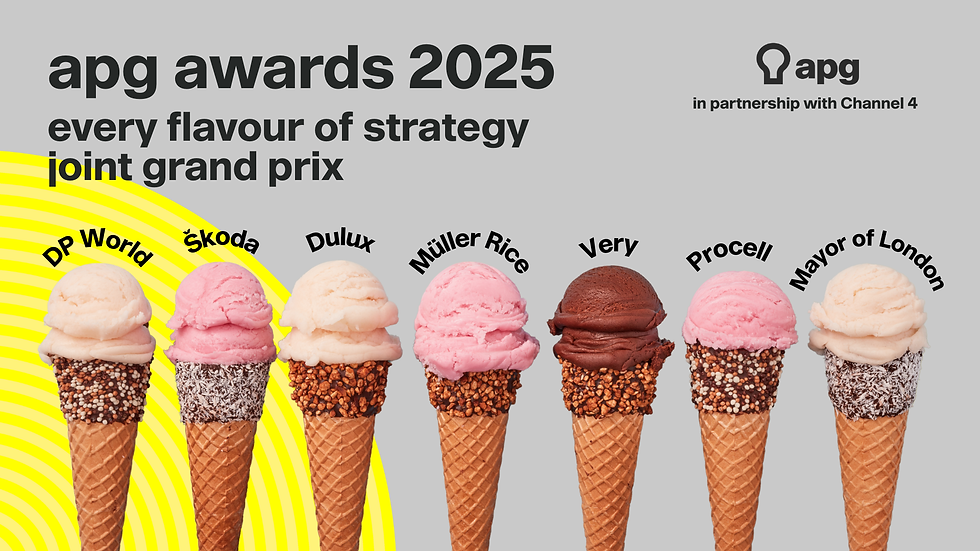Thinking Around Corners
- APG

- May 31, 2018
- 4 min read
The fourth instalment of Thinking Around Corners, run in partnership with the Firefish, took place at Google’s HQ in central London and the packed out audience had high expectations. Understandable, given the resounding success and positive feedback from our previous sessions.
Industry stalwarts Martin Weigel, Head of Planning, Wieden + Kennedy, Amsterdam and Richard Shotton, Deputy Head of Evidence at MG OMD were primed and ready to use unconventional thinking and uncommon sense to tackle the first of our 2 questions:
How do you get people to entertain facts that don’t accord with their world view?
First up was Richard, who spoke about a big challenge for planners and strategists - overcoming confirmation bias. Quoting Charlie Munger, he spoke about how we need to pick ‘moments of time’ in people’s lives to try to change their behaviour. This was particularly true in moments of personal change, when a new life event happens, such as a birthday or a wedding. People seem to be more open to shifting their world view when there are ‘discontinuities’ in their personal timeline. To put Richard’s answer simply, if you want people to entertain facts that don’t accord with their world view, approach them when their identity is in a state of flux.
Martin opened with a bold statement: “facts are for losers”. In his view, there is no point in arguing over facts because it is a person’s opinion that shapes their perception of the facts. He drilled this point home with a quote from Anaïs Nin – “we don’t see things as they are, we see them as we are”.

He also stressed that the human ego comes into play during arguments about facts because it subconsciously works to protect itself from anyone and anything that doesn’t entirely agree with it. Therefore, choosing to argue over facts is in effect an assault on the other party’s ego.
Martin selflessly offered four survival tips to help to navigate fact versus opinion minefield:
Your ego is not your amigo
Don’t take it personally
Relax
Don’t seek agreement, seek understanding
His final advice to the room was to approach each brief by aiming to understand what is really going on behind the opinion, then telling a story about how your solution addresses it.
The second question of the evening was:
How do you get society/a client/a particular culture obsessed with safety to take risks?
Richard kicked off his second session with a slideshow of a series of analogue watch adverts from men’s lifestyle magazines. There was a murmur in the room as people started to notice an obvious trend. Every single timepiece was set at 10:10. This time was regarded as the industry standard for advertising because it does not obscure the face of the timepiece. However, further slides revealed that even digital watch adverts also displayed 10:10 – a redundant approach because there is no risk of any craftsmanship being obscured.

His main takeaway from the example above and others was that most categories in advertising are now forgetting that distinctiveness is noticeable. And if something is noticeable, it's memorable. He urged the room to start adopting a culture within their own companies where it is shameful and toxic to play it safe and stick to the conventional, purely for their own career safety.
Martin returned to the floor and answered the question with a simple “you don’t”. For him, the pursuit of “brave” work should be reserved for internal teams. It encourages creative thinking that isn’t restricted by roadblocks like best practice, conventions or expectation.
He cautioned against using the “b” word with clients because it introduces the possibility of danger and failure. Alluding to the fact that your work might fail is unlikely to instill confidence that you can influence and engage with their potential consumers.
Martin asserted that the best planners and strategists always strive to create work that is “right” – right for the brand, the consumer, the culture, the channel or the business objective.
His finished by urging the audience to encourage bravery internally but demonstrate rightness externally.
There were good questions from the audience; one asking about the role of ‘consumer’ research in breakthrough thinking; Martin, in particular, felt it had a strong role to play – as long as it was “the right kind of research” - by this meaning strategic, often early-stage, exploratory, and sensitive to the wider landscape so it can have a much larger impact across the planning cycle.
Jem Fawcus, Firefish’s Group CEO closed the evening by summing up and sharing some thoughts about Thinking Around Corners so far.
Noting the very high quality of speakers this evening and across the series, Jem reflected on how brands – and indeed the world – needed ‘thinking around corners’ more than ever. And just as there might seem to be ever more intractable problems and tricky briefs, there are also exciting opportunities to do something fresh and distinctive (as neatly heralded in the quote from Dickens’ A Tale of Two Cities atop Martin’s blog; “It was the best of times, it was the worst of times…”)
Jem reminded the audience of the definition of an insight – an observation framed in such a way that it changes understanding of the situation and suggests action – exactly the sort of breakthrough encapsulated in ‘thinking around corners. His go-to heuristic is to ‘think differently’, bring an unconventional approach – shared by many of the approaches we saw this evening like: reframe the question, answer a different question – or even show why the question isn’t valid.
He ended with a small plea for the audience not to forget the power insight from real people and real lives in thinking around corners. Great understanding and intuition can be gained from immersion into human life and great insight derived from it…the enduring power of “the right kind of research”. Get in touch if you want some.





Comments